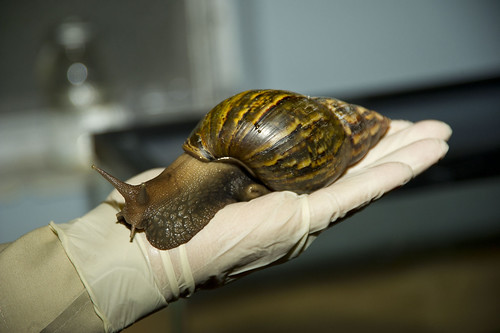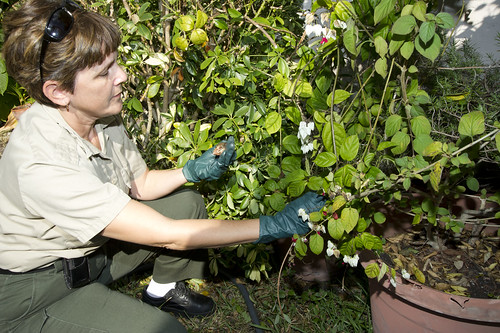
For the past several months, USDA’s Animal Plant Health Inspection Service (APHIS) and its partners at the Florida Department of Agriculture and Consumer Services (FDACS) have been fighting to stop the spread of the giant African snail—a nasty invasive pest that threatens Florida’s agricultural sector.
Big and slimy, the giant African snail is well-equipped to become an invasive species: they have voracious appetites, reproduce quickly, live a long time, and have no natural predators in Florida. The first snails were discovered and reported by a Miami homeowner in September 2011. In just six months, APHIS and FDACS have collected more than 40,000 of these giant creepy crawlies.

Unfortunately, this isn’t the first time we’ve faced this damaging invasive pest. Back in 1966, a boy smuggled three giant African snails into South Florida upon returning from a trip to Hawaii. His grandmother eventually released the snails into her garden. Those initial three snails grew into one giant family—after completing a 10 year, $1 million eradication campaign, we had collected and destroyed more than 18,000 snails!
Originally from East Africa, the snail has established itself throughout the Indo-Pacific Basin, including the Hawaiian Islands, and has been introduced into the Caribbean. Like other invasive species, giant African snails could enter the United States as hitchhikers on imported cargo. More often than not, however, the snails are smuggled illegally into the United States as pets or for food. When released into the environment, they can wreak major havoc on agriculture and the environment—much like what is happening in Florida right now.
Alert homeowners are the first line of defense in reporting signs of snail infestations. Please do your part in the fight against invasive species—if you have a giant African snail or see the snails or signs of their presence, call FDACS’ toll-free helpline at 888-397-1517. We caution against handling the snails, but if you must, we recommend wearing gloves and washing your hands thoroughly afterwards.
Everyone can help protect our precious resources and preserve our agricultural heritage by leaving hungry pests behind. When people are boating, fishing, birdwatching, hiking or even just cooking out in the backyard, there is an opportunity to fight invasive pests. To learn more about what state and federal agencies are doing to stop invasive pests and to learn of seven ways you can help leave them behind, please visit www.hungrypests.com.
USDA’s Animal and Plant Health Inspection Service (APHIS) has declared April as Invasive Plant Pest and Disease Awareness Month. Throughout the month, APHIS will post a series of blog entries here and also share invasive plant pest and disease information through our twitter feed. APHIS and its federal and state partners are fighting to protect our communities, our public lands, and our agricultural resources from invasive species.

